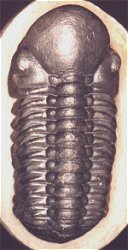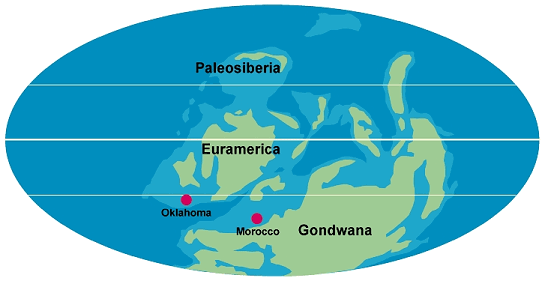
Early Paleozoic Animation (left) by C.R. Scotese ©2003, PALEOMAP Project.

|
Trilobites occupied marine environments from tropical equatorial
to polar paleolatitudes. Some families of trilobites were narrow in their
requirements. For example, the family Bathyuridae (Proetida:Bathyuroidea)
was found only in paleoequatorial regions. Trilobite marine niches ranged
from intertidal and nearshore to deep continental slopes. Because there
was very significant continental movement during the Paleozoic Era, with
continents drifting apart, as well as converging and joining, the distribution
and evolution of trilobites over the nearly 300 million years of their existence
reflects a complex paleogeography. For example, the locations of two famous trilobite-bearing sites, Burgess Shale (Canada) and Chengjiang (China) are in temperate zones now,
but in the Cambrian, were tropical. Early Paleozoic Animation (left) by C.R. Scotese ©2003, PALEOMAP Project. |
Taxon similarities between Devonian Oklahoma and Morocco Trilobite Assemblies

|

|

|
| Family Dalmanitidae
Huntoniatonia oklahomae (Oklahoma) |
Family Odontopleuridae
Dicranurus hamatus (Oklahoma) |
Family Phacopidae
Reedops deckeri (Oklahoma) |

|

|

|
| Family Dalmanitidae
Odontochile hausmanni (Morocco) |
Family Odontopleuridae
Dicranurus monstrosus (Morocco) |
Family Phacopidae
Reedops maurulus (Morocco) |
What explains the similarities? While the Oklahoma and Morocco trilobite sites are well-separated on today's globe (top figure below), Gondwana and Euramerica were in much closer proximity during the Devonian, with their continental shelfs nearly contiguous. The ancient Moroccan site and Oklahoma site were also at similar paleolatitudes, leading to the development of extremely similar ecosystems, trilobite species, and fossil assemblages.
| Huntoniatonia oklahomae Haragan Oklahoma 
|

Above: Although Oklahoma and Morocco are widely separated today, their trilobite assemblies are strikingly similar. |
Odontochile hausmanni Hamar Laghdad Morocco 
|
| Huntoniatonia oklahomae Haragan Oklahoma 
|

to have sprung from shared ancestral taxa that developed separately on the different continental shelf systems. |
Odontochile hausmanni Hamar Laghdad Morocco 
|

Species patterns such as the one above have been found in many post-Cambrian trilobite sites in every region of the world. In many cases, the regional endemic species were found in the nearshore and carbonate mound habitats, while wider-ranging taxa were found in deeper waters, reflecting a pelagic life history and distribution, such as shown in Carolinites (below).

Carolinites genacinaca has the widest global distri- bution of any species of trilobite |
Paleogeography vs modern fossil distribution The patterns of trilobite fossil distribution on today's continents can be bewildering unless the movements of continents during the Paleozoic is taken into account. Indeed, the consistent patterns and correlation of certain trilobite genera and families with certain regional biofacies over time helped deduce the positions of the paleocontinents, such as Gondwana, Laurentia, Paleosiberia, etc. For example, the trilobite Carolinites genacinaca (Proetida:Telephinidae) is today found in such far-flung and geographically disparate places as subtropical Australia, the western US, the northern arctic, eastern Siberia, and southeast China (see top map below). However, when we look at the global configuration at the time that Carolinites was alive, we see that all of those locations were tropical equatorial, that Carolinites was a widespread epipelagic species of the time (bottom map below). As can be seen from the image of the species (left), it had large eyes and a streamlined body form diagnostic of free-swimming pelagic species (a reconstruction of Carolinites in a venter-up swimming posture is presented here, immediately below). Indeed, it is thought to be the trilobite with the widest global distribution, past or present. |
| A reconstruction of a swimming
Carolinites This image depicts Carolinites in a possible swimming posture. The inverted swimming position, with limb gills serving as paddles, is typical of many aquatic or marine arthropods today (for example, fairy shrimp). No limbs of Carolinites have ever been recorded. The presence of long antennae and pygidial cerci is also conjectural. Note that the large eyes would offer an excellent field of view in either this position or one with limbs oriented downward. |

|


